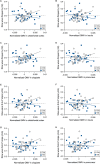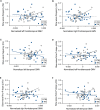Cerebral Gray Matter May Not Explain Sleep Slow-Wave Characteristics after Severe Brain Injury
- PMID: 38844342
- PMCID: PMC11308330
- DOI: 10.1523/JNEUROSCI.1306-23.2024
Cerebral Gray Matter May Not Explain Sleep Slow-Wave Characteristics after Severe Brain Injury
Abstract
Sleep slow waves are the hallmark of deeper non-rapid eye movement sleep. It is generally assumed that gray matter properties predict slow-wave density, morphology, and spectral power in healthy adults. Here, we tested the association between gray matter volume (GMV) and slow-wave characteristics in 27 patients with moderate-to-severe traumatic brain injury (TBI, 32.0 ± 12.2 years old, eight women) and compared that with 32 healthy controls (29.2 ± 11.5 years old, nine women). Participants underwent overnight polysomnography and cerebral MRI with a 3 Tesla scanner. A whole-brain voxel-wise analysis was performed to compare GMV between groups. Slow-wave density, morphology, and spectral power (0.4-6 Hz) were computed, and GMV was extracted from the thalamus, cingulate, insula, precuneus, and orbitofrontal cortex to test the relationship between slow waves and gray matter in regions implicated in the generation and/or propagation of slow waves. Compared with controls, TBI patients had significantly lower frontal and temporal GMV and exhibited a subtle decrease in slow-wave frequency. Moreover, higher GMV in the orbitofrontal cortex, insula, cingulate cortex, and precuneus was associated with higher slow-wave frequency and slope, but only in healthy controls. Higher orbitofrontal GMV was also associated with higher slow-wave density in healthy participants. While we observed the expected associations between GMV and slow-wave characteristics in healthy controls, no such associations were observed in the TBI group despite lower GMV. This finding challenges the presumed role of GMV in slow-wave generation and morphology.
Keywords: electroencephalography; gray matter atrophy; region-of-interest analysis; sleep slow waves; traumatic brain injury.
Copyright © 2024 the authors.
Conflict of interest statement
The authors declare no competing financial interests.
Figures




Similar articles
-
Differences in Cortical Gray Matter Atrophy of Paraplegia and Tetraplegia after Complete Spinal Cord Injury.J Neurotrauma. 2019 Jun 15;36(12):2045-2051. doi: 10.1089/neu.2018.6040. Epub 2019 Feb 6. J Neurotrauma. 2019. PMID: 30430910
-
Brain white matter damage and its association with neuronal synchrony during sleep.Brain. 2019 Mar 1;142(3):674-687. doi: 10.1093/brain/awy348. Brain. 2019. PMID: 30698667 Free PMC article.
-
Severe Traumatic Brain Injury Patients without Focal Lesion but with Behavioral Disorders: Shrinkage of Gray Matter Nuclei and Thalamus Revealed in a Pilot Voxel-Based MRI Study.J Neurotrauma. 2018 Jul 1;35(13):1552-1556. doi: 10.1089/neu.2017.5242. Epub 2018 Apr 30. J Neurotrauma. 2018. PMID: 29648977
-
Cortical and Subcortical Gray Matter Volume in Youths With Conduct Problems: A Meta-analysis.JAMA Psychiatry. 2016 Jan;73(1):64-72. doi: 10.1001/jamapsychiatry.2015.2423. JAMA Psychiatry. 2016. PMID: 26650724 Review.
-
COVID-19 is associated with changes in brain function and structure: A multimodal meta-analysis of neuroimaging studies.Neurosci Biobehav Rev. 2024 Sep;164:105792. doi: 10.1016/j.neubiorev.2024.105792. Epub 2024 Jul 3. Neurosci Biobehav Rev. 2024. PMID: 38969310 Review.
References
MeSH terms
LinkOut - more resources
Full Text Sources
Medical
